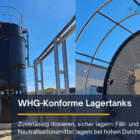Adsorption is a key physico-chemical process in industrial water treatment in which molecules or ions from a liquid or gas adhere to the surface of a solid. This occurs either through physisorption (weak intermolecular forces) or chemisorption (strong chemical bonds). Adsorption is particularly important in wastewater treatment to remove dissolved pollutants such as heavy metals, organic compounds or dyes from the water.
Table of contents
Technical background
Adsorption is based on the surface activity of a solid, usually a porous material such as activated carbon, silica gel or zeolites. Due to their high specific surface area, these materials offer a large number of adsorption sites on which the pollutants can be bound.
Physisorption: Molecules adhere to the surface of the adsorbent through van der Waals forces. This process is usually reversible, as no chemical bonds are formed between the adsorbate (the substance being adsorbed) and the adsorbent (the solid).
Chemisorption: This process is stronger and irreversible, as covalent bonds are formed between the adsorbate and the adsorbent. This is used to remove compounds that are difficult to break down or highly toxic substances.
Application in the practice of water and wastewater treatment
In industrial wastewater treatment, adsorption plays a crucial role in removing pollutants from the water before it is returned to the cycle or discharged.
Activated carbon is the most commonly used adsorbent in drinking water treatment and wastewater treatment. It is used in particular to remove organic pollutants, odors and flavors, pesticides and heavy metals such as mercury or lead.

Photo: Activated carbon filter in GRP tanks(ALMA FIL AK)
Ion exchangers: Another important adsorption process is ion exchange, in which dissolved ions such as heavy metals (e.g. copper, zinc) or nitrates are exchanged for harmless ions. This is particularly relevant in boiler water treatment and cooling water treatment, where the formation of deposits and corrosion must be prevented. Our ALMA ION systems are an example of ion exchanger systems in water treatment.
Zeolites and silica gel: Zeolites or silica gel are also used as adsorbents in special applications, for example to remove organic solvents or hydrocarbons from waste water.
Advantages and challenges of adsorption
Advantages:
- High efficiency in the removal of specific pollutants, even at low concentrations.
- Relatively simple implementation in existing water treatment systems.
- Wide range of applications in drinking water treatment, industrial wastewater treatment and air pollution control.
Challenges:
- The capacity of the adsorbent is limited, so regular regeneration or renewal is required to maintain adsorption performance.
- The selection of a suitable adsorbent must be adapted to the composition of the wastewater in order to achieve optimum performance.
Conclusion
Adsorption is an indispensable process in industrial water treatment. Whether through activated carbon (ALMA FIL AK), ion exchange (ALMA ION) or other specialized adsorbents - the effective removal of pollutants ensures that high water quality requirements are met. In combination with other treatment technologies, adsorption helps to significantly reduce the environmental impact of industrial processes.








